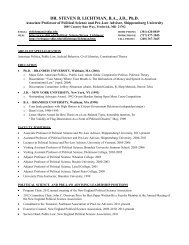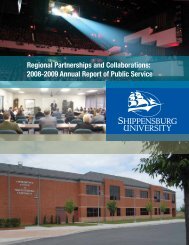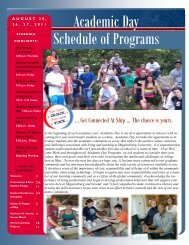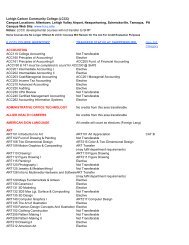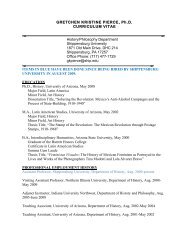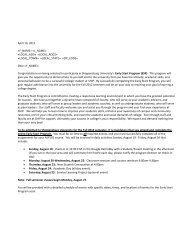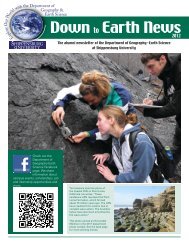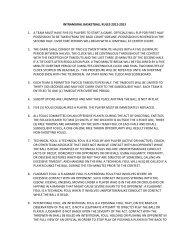Complete Issue - Shippensburg University
Complete Issue - Shippensburg University
Complete Issue - Shippensburg University
- No tags were found...
You also want an ePaper? Increase the reach of your titles
YUMPU automatically turns print PDFs into web optimized ePapers that Google loves.
19Georgia’s Water Future: Evolvingtoward Sustainability?G a i l Co w i eG e o r g i a De p a r t m e n t o f n a t u r a l Re s o u r c e sL e i g h As k e w a n d Co u r t n e y To b i nU niversity o f Ge o r g i a Fa n n i n g In s t i t u t eWe all know of water as a force of change, alteringthe landscape through slow, steady erosion and episodic,powerful floods. In the State of Georgia, over the pastfive years, we have seen water act as a different kind offorce. Water, or more precisely, concerns about pendingscarcity of water, have acted as a force for institutionalchange. Due to an uncommon coincidence of factors,the state’s water management institutions are nowshifting toward forms that, on the face at least, are moreconsistent with sustainable use of water resources.Compared with much of the world, the easternUnited States is a water-rich region. Georgia, forexample, receives an annual average of 50 inches of rainstatewide. Unlike the western United States, easternwater management institutions, including Georgia’s,were established and developed in a climate of plenty.Over the last four decades, water managementdecisions were largely made in response to specificissues or needs. Systematic evaluation of resources andplanning for long-term use was limited and on local or,at best, regional scales.In recent decades, however, population growth,economic expansion, and changes in technology havemarkedly increased demands on the state’s waterresources. At the same time, regional differences inwater resources and the way they are used have becomemore dramatic. Evidence of stresses and adverseimpacts on the water resources in three regions of thestate has emerged. In southeast Georgia, groundwaterwithdrawals have contributed to saltwater intrusion anda decline in water quality in some portions of a majoraquifer. In southwest Georgia, ground and surfacewater withdrawals have combined to alter surfacewater flows in some watersheds. And, in the Atlantametropolitan region in north Georgia, questions havebeen raised about the impacts of poor water quality onthe region’s economic future as well as the long-termviability of its water sources. Concerns about all ofthese factors, in turn, have been exacerbated by a seriesof major droughts and interstate litigation over waterresources.By the late 1990s, these factors began to raise broadbasedconcerns about growing stresses on Georgia’swater resources and the potential for long-term waterscarcity in some areas of the state. A legislative studycommittee ultimately resulted in legislation thatauthorized water planning with a scope not beforeundertaken in Georgia. 1Similar dynamics are evident throughout the easternUnited States, and states have responded to thesechallenges with a variety of approaches to statewideand regional water planning. 2 Florida’s response isperhaps the most comprehensive, where the state’sregional water management districts systematicallyupdate water supply assessments and prepare regionalwater supply plans. In 2001, for example, four of theregional planning areas had resources that were deemedinsufficient to meet 20-year needs and were requiredto submit plans to achieve the necessary water resourcedevelopment projects. 3 A recent update showed someplans have achieved remarkable success in increasingcapacity, while others outline actions that, if taken, willprovide the area with enough water in 2025. 4Other states in the southeast are considering orproposing statewide water and regional planningprocesses. In South Carolina, a bill authorizingstatewide water planning was recently introduced inthe South Carolina General Assembly. 5 Legislatorsand stakeholders in Alabama have been exploring theoptions for statewide water planning “like Georgia’s”but a study committee recently concluded they do nothave enough data to submit a plan this year. 6Gail Cowie is a senior planning and policy adviser at the Georgia Department of Natural Resources and has over 20 yearsof experience with participatory development of environmental policy.Leigh Askew is a public service assistant at the <strong>University</strong> of Georgia’s Fanning Institute and has nearly ten yearsexperience in group facilitation and environmental decision-making.Courtney Tobin is a lawyer on the Public Service and Outreach faculty at the <strong>University</strong> of Georgia’s Fanning Institute andworks with communities on a variety of natural resources issues.



